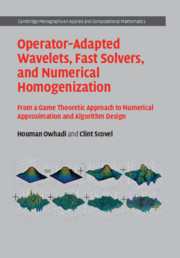 Operator-Adapted Wavelets, Fast Solvers, and Numerical Homogenization
Operator-Adapted Wavelets, Fast Solvers, and Numerical Homogenization Book contents
- Frontmatter
- Dedication
- Contents
- Preface
- Acknowledgements
- Reading Guide
- 1 Introduction
- Part I The Sobolev Space Setting
- Part II The Game Theoretic Approach
- Part III The Banach Space Setting
- 11 Banach Space Basics
- 12 Optimal Recovery Splines
- 13 Gamblets
- 14 Bounded Condition Numbers
- 15 Exponential Decay
- 16 Fast Gamblet Transform
- Part IV Game Theoretic Approach on Banach Spaces
- Part V Applications, Developments, and Open Problems
- Part VI Appendix
- Bibliography
- Algorithms
- Glossary
- Nomenclature
- Index
- Identities
11 - Banach Space Basics
from Part III - The Banach Space Setting
Published online by Cambridge University Press: 10 October 2019
- Frontmatter
- Dedication
- Contents
- Preface
- Acknowledgements
- Reading Guide
- 1 Introduction
- Part I The Sobolev Space Setting
- Part II The Game Theoretic Approach
- Part III The Banach Space Setting
- 11 Banach Space Basics
- 12 Optimal Recovery Splines
- 13 Gamblets
- 14 Bounded Condition Numbers
- 15 Exponential Decay
- 16 Fast Gamblet Transform
- Part IV Game Theoretic Approach on Banach Spaces
- Part V Applications, Developments, and Open Problems
- Part VI Appendix
- Bibliography
- Algorithms
- Glossary
- Nomenclature
- Index
- Identities
Summary
This chapter transitions the presentation to Banach spaces equipped with a quadraticnorm defined by a symmetric positive linear operator. Basic terminology and results are established (using a representation of the dual product that is distinct from the one obtained from the Riesz representation associated with such Banach spaces).
Keywords
Information
- Type
- Chapter
- Information
- Operator-Adapted Wavelets, Fast Solvers, and Numerical HomogenizationFrom a Game Theoretic Approach to Numerical Approximation and Algorithm Design, pp. 151 - 153Publisher: Cambridge University PressPrint publication year: 2019